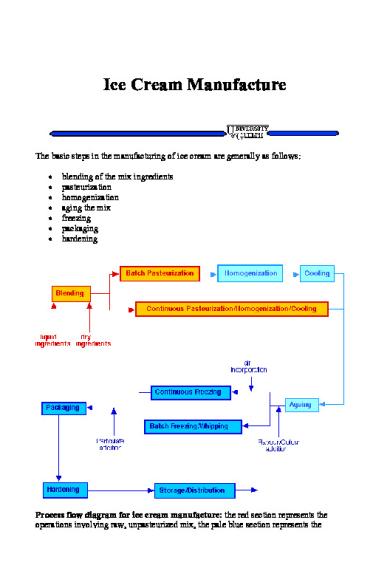* The preview only shows a few pages of manuals at random. You can get the complete content by filling out the form below.
Description
Ice Cream Manufacture
The basic steps in the manufacturing of ice cream are generally as follows: • • • • • • •
blending of the mix ingredients pasteurization homogenization aging the mix freezing packaging hardening
Process flow diagram for ice cream manufacture: the red section represents the operations involving raw, unpasteurized mix, the pale blue section represents the
operations involving pasteurized mix, and the dark blue section represents the operations involving frozen ice cream.
Blending First the ingredients are selected based on the desired formulation and the calculation of the recipe from the formulation and the ingredients chosen, then the ingredients are weighed and blended together to produce what is known as the "ice cream mix". Blending requires rapid agitation to incorporate powders, and often high speed blenders are used.
Pasteurization The mix is then pasteurized. Pasteurization is the biological control point in the system, designed for the destruction of pathogenic bacteria. In addition to this very important function, pasteurization also reduces the number of spoilage organisms such as psychrotrophs, and helps to hydrate some of the components (proteins, stabilizers). Pasteurization (Ontario regulations): 69° C/30 min. 80° C/25s Both batch pasteurizers and continuous (HTST) methods are used. Batch pasteurizers lead to more whey protein denaturation, which some people feel gives a better body to the ice cream. In a batch pasteurization system, blending of the proper ingredient amounts is done in large jacketed vats equipped with some means of heating, usually steam or hot water. The product is then heated in the vat to at least 69 C (155 F) and held for 30 minutes to satisfy legal requirements for pasteurization, necessary for the destruction of pathogenic bacteria. Various time temperature combinations can be used. The heat treatment must be severe enough to ensure destruction of pathogens and to reduce the bacterial count to a maximum of 100,000 per gram. Following pasteurization, the mix is homogenized by means of high pressures and then is passed across some type of heat exchanger (plate or double or triple tube) for the purpose of cooling the mix to refrigerated temperatures (4 C). Batch tanks are usually operated in tandem so that one is holding while the other is being prepared. Automatic timers and valves ensure the proper holding time has been met. Continuous pasteurization (see schematic diagram for mix here) is usually performed in a high temperature short time (HTST) heat exchanger following blending of ingredients in
a large, insulated feed tank. Some preheating, to 30 to 40 C, is necessary for solubilization of the components. The HTST system is equipped with a heating section, a cooling section, and a regeneration section. Cooling sections of ice cream mix HTST presses are usually larger than milk HTST presses. Due to the preheating of the mix, regeneration is lost and mix entering the cooling section is still quite warm. Homogenization The mix is also homogenized which forms the fat emulsion by breaking down or reducing the size of the fat globules found in milk or cream to less than 1 µ m. Two stage homogenization is usually preferred for ice cream mix. Clumping or clustering of the fat is reduced thereby producing a thinner, more rapidly whipped mix. Melt-down is also improved. Homogenization provides the following functions in ice cream manufacture: • • • •
Reduces size of fat globules Increases surface area Forms membrane makes possible the use of butter, frozen cream, etc.
By helping to form the fat structure, it also has the following indirect effects: • makes a smoother ice cream • gives a greater apparent richness and palatability • better air stability • increases resistance to melting Homogenization of the mix should take place at the pasteurizing temperature. The high temperature produces more efficient breaking up of the fat globules at any given pressure and also reduces fat clumping and the tendency to thick, heavy bodied mixes. No one pressure can be recommended that will give satisfactory results under all conditions. The higher the fat and total solids in the mix, the lower the pressure should be. If a two stage homogenizer is used, a pressure of 2000 - 2500 psi on the first stage and 500 - 1000 psi on the second stage should be satisfactory under most conditions. Two stage homogenization is usually preferred for ice cream mix. Clumping or clustering of the fat is reduced thereby producing a thinner, more rapidly whipped mix. Melt-down is also improved. Ageing The mix is then aged for at least four hours and usually overnight. This allows time for the fat to cool down and crystallize, and for the proteins and polysaccharides to fully hydrate. Aging provides the following functions: •
Improves whipping qualities of mix and body and texture of ice cream
. It does so by: • providing time for fat crystallization, so the fat can partially coalesce; • allowing time for full protein and stabilizer hydration and a resulting slight viscosity increase; • allowing time for membrane rearrangement and protein/emulsifier interaction, as emulsifiers displace proteins from the fat globule surface, which allows for a reduction in stabilization of the fat globules and enhanced partial coalescence. Aging is performed in insulated or refrigerated storage tanks, silos, etc. Mix temperature should be maintained as low as possible without freezing, at or below 5 C. An aging time of overnight is likely to give best results under average plant conditions. A "green" or unaged mix is usually quickly detected at the freezer.
Freezing and Hardening Following mix processing, the mix is drawn into a flavour tank where any liquid flavours, fruit purees, or colours are added. The mix then enters the dynamic freezing process which both freezes a portion of the water and whips air into the frozen mix. The "barrel" freezer is a scraped-surface, tubular heat exchanger, which is jacketed with a boiling refrigerant such as ammonia or freon. Mix is pumped through this freezer and is drawn off the other end in a matter of 30 seconds, (or 10 to 15 minutes in the case of batch freezers) with about 50% of its water frozen. There are rotating blades inside the barrel that keep the ice scraped off the surface of the freezer and also dashers inside the machine which help to whip the mix and incorporate air.
Ice cream contains a considerable quantity of air, up to half of its volume. This gives the product its characteristic lightness. Without air, ice cream would be similar to a frozen ice cube. The air content is termed its overrun, which can be calculated mathematically. As the ice cream is drawn with about half of its water frozen, particulate matter such as fruits, nuts, candy, cookies, or whatever you like, is added to the semi-frozen slurry which has a consistency similar to soft-serve ice cream. In fact, almost the only thing which differentiates hard frozen ice cream from soft-serve, is the fact that soft serve is drawn into cones at this point in the process rather than into packages for subsequent hardening. Hardening After the particulates have been added, the ice cream is packaged and is placed into a blast freezer at -30° to -40° C where most of the remainder of the water is frozen. Below about -25° C, ice cream is stable for indefinite periods without danger of ice crystal growth; however, above this temperature, ice crystal growth is possible and the rate of
crystal growth is dependant upon the temperature of storage. This limits the shelf life of the ice cream. A primer on the theoretical aspects of freezing will help you to fully understand the freezing and recrystallization process. Hardening invloves static (still, quiescent) freezing of the packaged products in blast freezers. Freezing rate must still be rapid, so freezing techniques involve low temperature (-40oC) with either enhanced convection (freezing tunnels with forced air fans) or enhanced conduction (plate freezers).
The rate of heat transfer in a frezing porcess is affected by the temperature difference, the surface area exposed and the heat transfer coefficient (Q=U A dT). Thus, the factors affecting hardening are those affecting this rate of heat transfer: • • •
•
•
Temperature of blast freezer - the colder the temperature, the faster the hardening, the smoother the product. Rapid circulation of air - increases convective heat transfer. Temperature of ice cream when placed in the hardening freezer - the colder the ice cream at draw, the faster the hardening; - must get through packaging operations fast. Size of container - exposure of maximum surface area to cold air, especially important to consider shrink wrapped bundles - they become a much larger mass to freeze. Bundling should be done after hardening. Composition of ice cream - related to freezing point depression and the temperature required to ensure a significantly high ice phase volume.
•
• •
Method of stacking containers or bundles to allow air circulation. Circulation should not be impeded - there should be no 'dead air' spaces (e.g., round vs. square packages). Care of evaporator - freedom from frost - acts as insulator. Package type, should not impede heat transfer - e.g., styrofoam liner or corrugated cardboard may protect against heat shock after hardening, but reduces heat transfer during freezing so not feasible.
Ice cream from the dynamic freezing process (continuous freezer) can also be transformed into an array of novely/impulse products through a variety of filling and forming machines, which have ben identified on a separate page.



